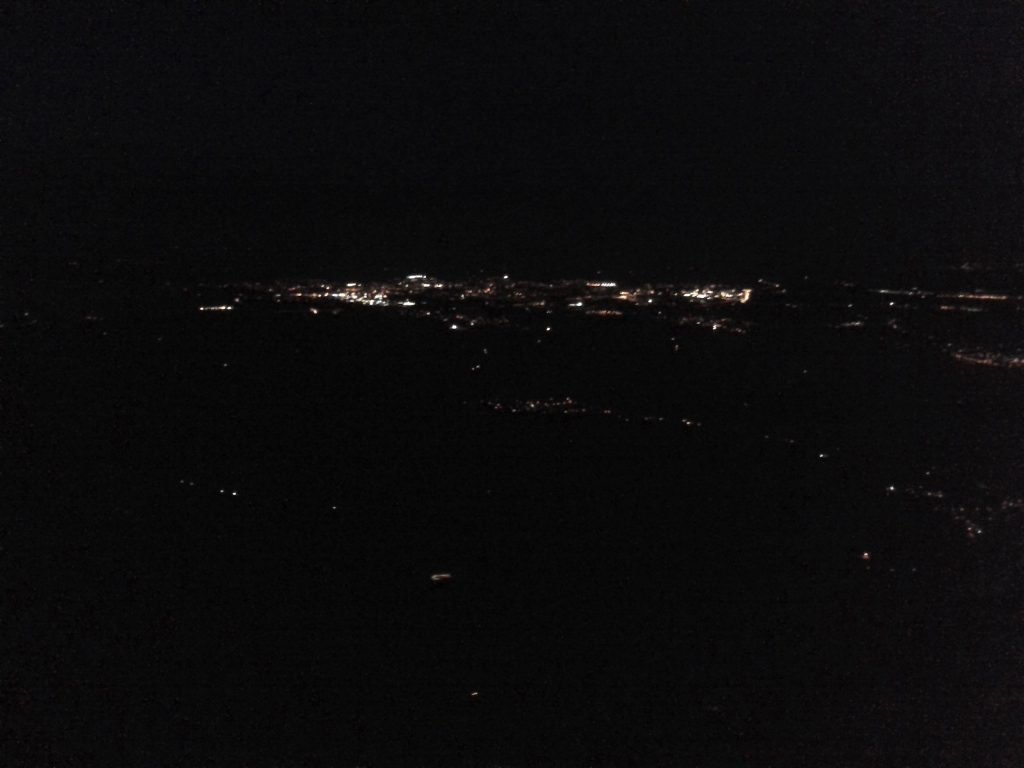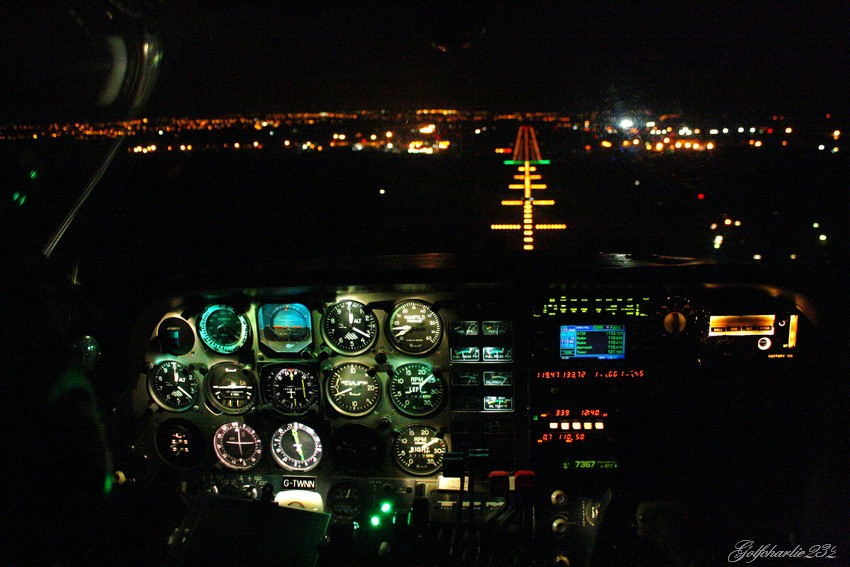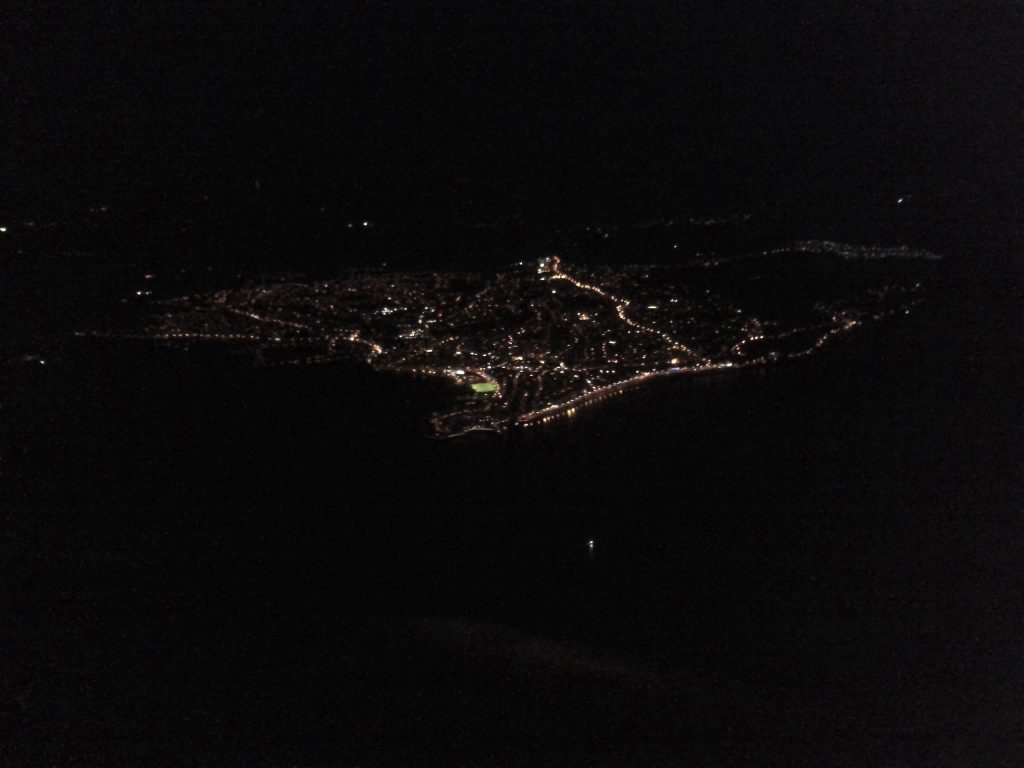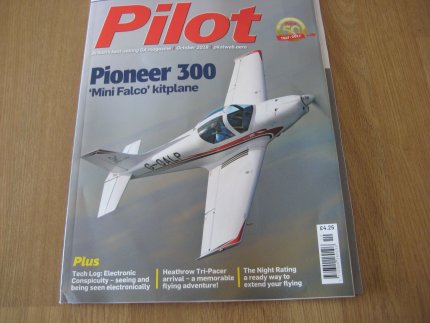A couple of evenings ago, I had an awe-inspiring flight that was a major first in my flying career.
I went for my first ever flight at night. With an instructor, of course.
At the moment, my licence only allows me to fly in daylight. In order to fly at night, I would need to add a Night Rating to my licence, which simply involves a short theoretical and practical flying training course and then five solo takeoffs and full-stop landings at night.
I have been thinking about going for my night rating for a good while now, shall I/shan’t I, will I like it, what if it’s really hard, what if I get all disorientated? The inspiration for the night flying came from one of those moments where I was standing in my garden at home and looking up at the brightly moonlit clouds above, and thinking, “I would love to fly up there in that sky!” And so was born the idea of training for my first additional rating in all my 20+ years of flying.
So I decided to go for a short hop with an Instructor and see how I liked it. As it was an instructional flight, I planned on flying the aeroplane for the entire flight, right from moving off from the apron to the final shutdown, as far as it was possible given that I had never flown at night before.
So, first, we had a little bit of a briefing, where Ollie (my Instructor) gave me some important points about the differences involved in flying at night as compared to daylight flying, and I asked a few questions. Then it’s engine startup and off we go.
The first thing I noticed was that it is really hard to read my checklist in the pitch black. I had brought my torch and used it, but I made a mental note that next time I would put a red filter on my torch so as to avoid loss of night vision.
So, engine start as normal, call the Tower, and then taxy the aeroplane to the holding point just short of the runway for the power and pre-takeoff ‘vital actions’ checks. The taxiways are lit with blue lights at the edges and green lights down the centreline, and there are two bright yellow flashing lights to mark the holding point. This wasn’t all that difficult although I did notice a tendency to overcontrol on the steering because of the lack of visual references. But essentially it was no harder than driving a car at night. Lining up on the runway, though, was a bit different because there were no cues at all apart from the white lines on the ground. All the lights on aerodrome surfaces are carefully aligned to cause minimum inconvenience by dazzle and maximum benefit for the different stages of flight. To be honest I don’t remember if I could see the main runway edge lights (the flarepath), but we were quickly cleared for takeoff so it’s off we go.
The takeoff itself was easy, not all that different from a daylight takeoff, but I think I would have found it hard in a crosswind, again because of the lack of visual cues. These visual cues are something that I have taken for granted in daylight flying, because everything is visible all around me and I don’t even think about it. At night, though, the default setting is that everything is black, everywhere, unless it’s a city or a road. But the wind was calm; a nice fine and quiet night weather-wise, just perfect for a night air experience flight.
In fact, the feeling is quite surreal as the aeroplane lifts off and I begin the climbout, just like I would in daylight, but relying on the instruments to maintain the correct airspeed and attitude. Everything is black, except for the bright lights of Exeter and its surrounding towns, and the bright car lights on the nearby M5 motorway, one stream of red tail lights, the other of white headlights. It’s rush hour so the roads are busy and easily visible even where there are no street lights, and the feeling is like climbing up into a huge black velvet coal sack but with all these islands and rivers of coloured lights (mainly orange, red and white) lighting up patches on the ground. Fortunately I know the geography of the local area really well so I am not fazed at all by thinking, like, ‘Where am I?’. That’s one major thing I don’t need to worry about.

I notice also that large water features, like the two major estuaries of the Exe and the Teign, actually reflect light from the sky that I didn’t even know was there; the Moon has not yet risen so the sky is lit mainly by starlight and a little bit of city glow, though not all that much as Devon is really very rural. In fact, I have read many times that water features are one of the best aids to night navigation, and now I can see why. Yeadon, my old home town near Leeds, has a lake near it that they had to drain during the War, because it is only a mile from a factory where they used to build Lancaster bombers. The lake would have been a major landmark that would have enabled German night bombers to attack the factory with some fair degree of accuracy. And the sea, of course, is a major feature around my current area, although it appears much darker than the rivers for some reason…but again it’s easily found because the coastal towns define the coastline really well. And there are all these little white lights dotted around that show where boats are located. You can see one just below the middle of this photo of Exmouth, taken from over Dawlish Warren at 2,500ft (photo is clickable for full-size image):
But the most striking feature, again, is the blackness. Everything is black apart from the towns and roads, and the rivers. In fact the feeling is like that of everything being almost abstract; it’s like I’m not really flying but instead I’m using a flight simulator or something. Because the aeroplane, once trimmed up, basically flies herself, all I need to do is to look out at the view and occasionally check the instruments for height, heading and speed. I know I’m above the MSA (minimum safe altitude) so I’m not going to run into anything. Other aircraft are easy to spot as they have flashing lights on them. In a lot of ways, despite the lack of a visual horizon reference, this is much easier than flying in the daylight. Quite a paradox.
And I can see. Although most of the ground is dark, I notice that there is actually enough light to see by due to the starlight, now that my eyes are becoming accustomed to the dark.
Straight away I notice that I am flying the aeroplane much more precisely and carefully, being careful not to risk disorientation by abrupt attitude changes, and paying much more attention to the instruments and what the aeroplane is doing. When flying, it’s really important to keep ahead of the aircraft at all times; to be proactive rather than reactive, so I am concentrating hard and thinking well ahead because at night it is so much more vital to be ahead of your game. Any tendency of the aeroplane to drift off course or change its attitude has to be seen and acted on early so that it does not ‘develop’. This is probably the most precise flying I have done in a long while.
Coming back to the airport, Ollie points out landmarks that will be useful for me when trying to find the aerodrome by myself. How does one lose a huge field with a 2,064-metre runway? Quite easily, actually 🙂 But the airport does indeed appear as advertised, and I position for a left-hand downwind join for Runway 26. Doing everything slowly, carefully and precisely, I fly a very nice downwind in all this blackness; several landmarks are available to help me in this regard but I also need to make sure that I am well clear of high ground to the east of the airport and below the place where I am going to do the base turn. Downwind checks complete, and turning base, then, at about 1,100ft, the runway approach lights gradually become more visible as a dim string of yellow dots as I prepare the aeroplane for landing. Turning for final approach, the runway is lit up gloriously – I have done dusk flarepath landings before, so the sight is familiar – but in between the flarepath lights, the runway surface itself is totally black.

I’ve been briefed by Ollie on when to ‘flare’ (the point where you arrest the descent); apparently it’s when the runway lights appear to be coming up around my ears. So I flare and prepare to hold off, but the aeroplane touches down straight away for a real greaser of a landing; almost perfect – except that it was pure fluke. I didn’t expect the aircraft to land so soon; normally she needs to be held off the runway until she stalls gently on from about 8-12 inches above the runway. Again, the lack of visual cues is something I’m going to have to learn to deal with.
I was surprised in that I actually flew the entire flight myself, with the exception of a minute or two where Ollie took over so I could take the two photos featured in this blog post, and the whole flight was easy, if a little surreal. But the precision flying I will have to perform will do nothing but good for my flying technique.
And so my training starts on Monday, weather permitting. For the first time in 20 years, I will be undergoing a flying training programme. I did have a lesson or two a couple of years ago, where I learned things like radio navigation and such, but this will be the first really new formal flying training program that I have done since completing my PPL in 1997. Once again, I will have to summon all my courage, discipline and determination to make this work. The courage to face new and potentially dangerous situations, the discipline of concentration and excluding all extraneous thoughts from my fizzing Aspie mind; and the determination to overcome all the obstacles to learning that I will likely encounter, and come through with my shiny new Night Rating. It will be really freeing to be able to not worry about whether or not I am down before sunset. And I love the flarepath landings; it’s all very pretty.
Outside the local supermarket yesterday evening, I looked up into the black sky and thought, “Crumbs, I flew in that last night!” Well, hopefully I’m going to be doing a lot more of it over the winter months.
Wish me luck!
[Edit] I completed my Night Rating at the end of November 2017, and wrote up my experiences (including sections of this present piece) to be submitted for publication. My article was published in the October 2018 edition of the UK’s best-selling General Aviation magazine, Pilot, and occupied five pages including photos. Very pleased 🙂
[Second edit] – Now that my published article has been out for a few months, it’s become freely available on the Pilot Magazine website. If you’d like to have a read of it (it’s similar to this present article, and obviously based on it, but there are some differences) then here is the link.





I loved this post. You tell a good story. 🙂
Hehe thanks 🙂 I suppose I wanted to share what it felt like, because not everyone gets the chance to experience it for themselves…